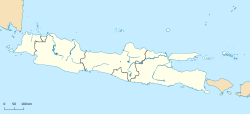| Borobudur Temple Compounds | |
|---|---|
| Native name Kompleks Candi Borobudur (Indonesian) | |
| Location | Magelang, Central Java |
| Coordinates | 7°36′29″S110°12′14″E / 7.608°S 110.204°E |
| Type | Cultural |
| Criteria | i, ii, vi |
| Designated | 1991 (15th session) |
| Reference no. | 592 |
| Region | Southeast Asia |
| Includes | Borobudur Mendut Pawon |
Borobudur Temple Compounds is the World Heritage designation of the area of three Buddhist temples in Central Java, Indonesia. It comprises Borobudur, Mendut, and Pawon. The temples were built during the Shailendra dynasty around the 8th and 9th centuries CE and fall on a straight line.
Contents
Approximately 40 kilometres (25 mi) northwest of Yogyakarta, Borobudur sits on a plateau between two twin volcanoes, Sundoro-Sumbing and Merbabu-Merapi, and two rivers, the Progo and the Elo. According to local myth, the area known as Kedu Plain is a Javanese sacred place and has been dubbed 'the garden of Java' due to its high agricultural fertility. [1]





